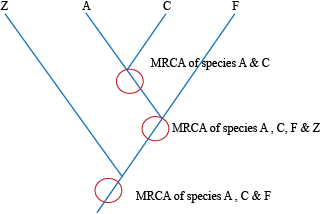Speciation Terms
Get down with the lingo
Adaptation
A characteristic or feature that is maintained by natural selection because it offers a fitness advantage.Allele Frequency
The frequency of a certain allele within a population or species, usually written as the percent of individuals that possess that allele.Allopatric
Two species are allopatric if their ranges are completely disconnected.Anagenesis
The evolutionary changes that occur within a lineage.Assortative Mating
A form of non-random mating in which individuals prefer to mate with other individuals that are similar to them in some important characteristic. In other words, like mates with like.Bell Curve
The statistical distribution (also known as a normal distribution) that has a mean of zero and a standard deviation of one.Cladogenesis
The evolutionary changes that result in the splitting of lineages.Congruence
In a state of agreement; if two ideas are in agreement with each other, there is congruence between them.Divergence
The accumulation of differences (genetic, behavioral, ecological, etc.) between two groups of the same lineage, often resulting in the splitting of that lineage into two distinct species.Fitness
The reproductive success of an individual or genotype.Fixation
When an allele frequency falls to 0% (meaning the allele is lost from the populations) or raises to 100% (meaning all individuals in the population have the allele).Gene Flow
The movement of genes through a population caused by interbreeding among individuals. There can also be gene flow between populations if migration occurs and is followed by interbreeding. Disruption of gene flow (via reproductive isolation) is required for speciation.Hybrid Infertility
Occurs when the hybrid offspring of two parent species does not produce fertile, viable, or compatible gametes and therefore cannot reproduce. Also known as Hybrid Sterility.Hybrid Inviability
Occurs when the hybrid offspring of two parent species has reduced fitness to the extent that it cannot mature into a healthy, reproductive adult.Hybrid
The resulting offspring from a successful mating of two different species.Hybridization
When members of different species mate to produce an offspring. If the resulting offspring is inviable or infertile then the parent species are considered distinct species. However, if the hybrid offspring is healthy and reproduces then it challenges the distinction between the two parent species.Incipient Species
a group of organisms that are thought to be on the brink of diverging into a distinct species, but are still capable of interbreeding with other members of the species.Intraspecific Variation
The variation (genetic or phenotypic) that exists among all the individuals of the same species.Inviable
Unable to live and/or develop, even under favorable conditions.Microhabitat
A small, specialized habitat within a larger habitat. Most habitats contain many microhabitats. For example, a pine forest habitat might include microhabitats such as underneath moist rocks, in the tree canopy, inside hollow trees, near streams, etc.MRCA (Most Recent Common Ancestor)
The most recent lineage from which all members of a given set of species descended. For example: